![]()
![]()
![]()
Use LEFT and RIGHT arrow keys to navigate between flashcards;
Use UP and DOWN arrow keys to flip the card;
H to show hint;
A reads text to speech;
101 Cards in this Set
- Front
- Back
|
What is scoliosis?
|
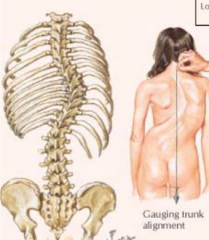
Abnormal lateral curvature of spine, abnormal rotation of one vertebra upon the other
--> genetic, trauma, idiopathic; adolescent girls more than boys |
|
|
What is kyphosis?
|
Hunchback - accentuated flexion of thoracic spine --> poor spine, osteoporosis
|
|
|
What is lordosis?
|
Swayback - accentuated extension of lumbar spine --> weakened trunk muscles, late pregnancy, obesity
|
|
|
What part of the axis (C2) is most commonly affected by a fracture? What are the types/degrees?
|

Dens: 3 types -
I) fracture of tip - usually stable II) fracture of base or neck - unstable III) fracture extends into body of axis - reunite well when immobilized |
|
|
Besides the dens, what kind of fractures can happen to the axis (C2)?
|

Hangman fracture - through neural arch / pedicle - can be stabilized, if survived with or w/o spinal cord damage
|
|
|
What kind of fracture can happen to the atlas (C1)?
|
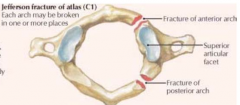
Jefferson fracture - burst fracture of the atlas, often caused by a blow to the top of the head
|
|
|
What is the most common type of arthritis?
|
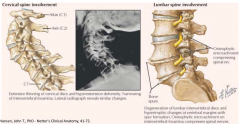
Osteoarthritis - erosion of articular cartilage of weight-bearing joints such as those in vertebral column
|
|
|
What is the cause of osteoarthritis? Where?
|
Progressive erosion of cartilage in joints of spine, fingers, knee, and hip (most common)
|
|
|
What are the risk factors for Osteoarthritis?
|
- Age
- Female sex - Joint trauma - Repetitive stress - Obesity - Genetic - Race - Previous inflammatory joint disease |
|
|
What are some potential complications of osteoarthritis?
|
- In spine, involves IV discs and facet joints
- Leads to hyperextension deformity and spinal nerve impingement |
|
|
What is the most common bone disease?
|

Osteoporosis (porous bone) - imbalance of bone resorption and formation, which places bones at a great risk for fracture
|
|
|
What is the cause of Osteoporosis?
|
- Postmenopausal women
- Genetics - Vitamin D synthesis deficiency - Idiopathic |
|
|
What are the risk factors for Osteoporosis?
|
- Family history
- White female - Increasing age - Estrogen deficiency (menopause) - Vitamin D deficiency - Low Ca2+ intake - Smoking - Alcohol - Inactive lifestyle |
|
|
What are the potential complications of Osteoporosis?
|
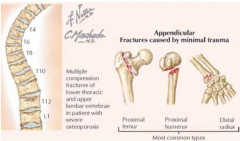
- Vertebral compression fractures
- Fracture of proximal femur or humerus, ribs, and distal radius (Colles' fracture) |
|
|
What is Spondylolysis?
|

Congenital defect or an acquired stress fracture of the vertebral lamina that presents w/ no slippage of adjacent articulating vertebrae (Scottie dog w/ collar)
|
|
|
Where is the most common site of Spondylolysis and Spondylolisthesis?
|
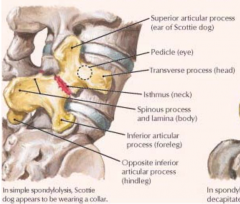
L5-S1
|
|
|
What is Spondylolisthesis?
|
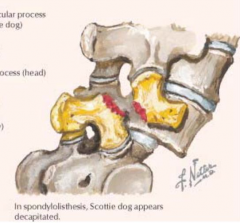
Bilateral defect (complete dislocation) resulting in an anterior displacement of vertebral body and transverse process while posterior fragment remains in proper alignment over sacrum (Scotty dog w/ broken neck)
|
|
|
What causes low back and lower limb pain in Spondylolisthesis?
|

Pressure on spinal nerves
|
|
|
What is the most common musculoskeletal disorder?
|
Low back pain
|
|
|
What are the most common causes of low back pain?
|
- Intervertebral disc rupture and herniation
- Nerve inflammation or compression - Degenerative changes in vertebral facet joints - Sacroiliac joint and ligament involvement - Metabolic bone disease - Psychosocial factors - Abdominal aneurysm - Metastatic cancer - Myofascial disorders |
|
|
What is responsible for back pain when there are changes in the vertebral facet (zygapophyseal) joints?
|
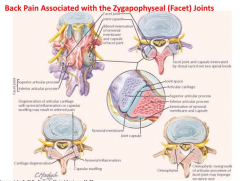
- Sensory nerve fibers, derived from the dorsal rami of spinal nerves, supply the synovial linings of the capsules surrounding the joints
- Degeneration of the articular cartilage or osteophytes (bony outgrowths) of the facet articular processes can cause pain - Responsible for ~15% of back pain |
|
|
What are the important vertebral joints?
|
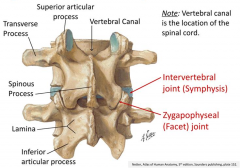
- Intervertebral joint (symphysis)
- Zygapophyseal (facet) joint |
|
|
What are the two components of the intervertebral disc?
|
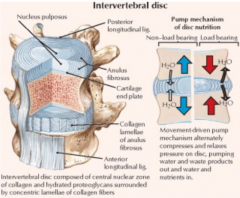
- Nucleus pulposus - central nuclear zone of collagen and hydrated proteoglycans - acts as shock absorber
- Anulus fibrosus - concentrentic lamellae of collagen fibers |
|
|
What can happen with repeated compression-relaxation cycles on intervertebral discs?
|
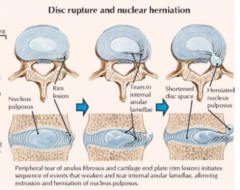
- Peripheral tears of anulus fibrosus
- Extrusion and herniation of more gelatnious nucleus pulposus - Often occurs w/ age as N.P. becomes more dehydrated, transferring more of the compression forces to the anulus fibrosus - Causes thickening of anulus and tears |
|
|
What direction do most disc herniations occur in?
|
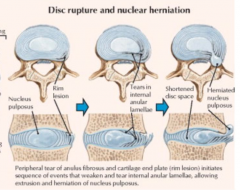
- Posterolateral direction - because anulus fibrosus tears often occur at posterolateral margins of disc (rim lesions)
- Posterior longitudinal ligament reinforces the anulus, therefore posterior herniations are much less likely |
|
|
What would happen if the posterior longitudinal ligament wasn't supporting the anulus fibrosus?
|
Disc herniations could occur posteriorly which could compress the spinal cord and nerve roots
|
|
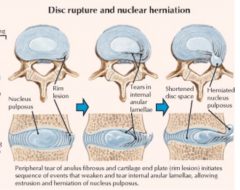
What are the most common sites for disc herniation? Implications?
|
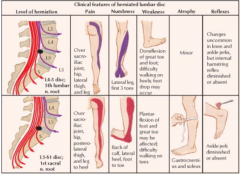
- Cervical: C5-C6, C6-C7 --> pain in shoulder/upper limb
** Lumbar: L4-L5, L5-S1 --> pain over SI joint, hip, posterior thigh, and leg |
|
|
What are the features of a L4-L5 disc herniation (impinging L5 nerve):
- Pain - Numbness - Weakness - Atrophy - Reflexes |
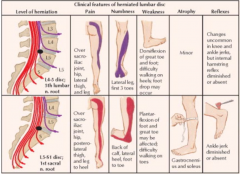
- Pain: over SI joint, hip, lateral thigh, and leg
- Numbness: lateral leg, first 3 toes - Weakness: dorsiflexion of great toe and foot, difficulty walking on heels, foot drop may occur - Atrophy: minor - Reflexes: internal hamstring reflex diminished or absent |
|
|
What are the features of a L5-S1 disc herniation (impinging S1 nerve):
- Pain - Numbness - Weakness - Atrophy - Reflexes |

- Pain: SI joint, hip, postero-lateral thigh, leg to heel
- Numbness: back of calf, lateral heel, foot to toe - Weakness: plantar-flexion of foot and great toe, difficulty walking on toes - Atrophy: gastrocnemius and soleus - Reflexes: ankle jerk diminished or absent |
|
|
What is the difference in weakness for L4-L5 vs L5-S1 disc herniation?
|
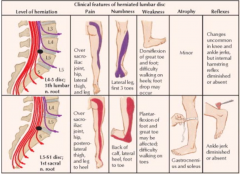
- L4-L5: dorsiflexion of great toe and foot; difficulty walking on heels, foot drop
- L5-S1: plantarflexion of foot and great toe; difficulty walking on toes |
|
|
What is the difference in atrophy for L4-L5 vs L5-S1 disc herniation?
|
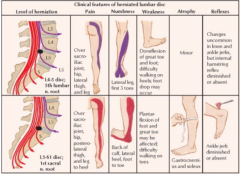
- L4-L5: minor
- L5-S1: gastrocnemius and soleus |
|
|
What is the difference in reflexes for L4-L5 vs L5-S1 disc herniation?
|
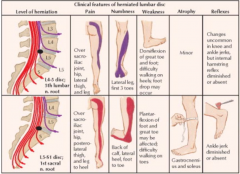
- L4-L5: diminished or absent internal hamstring reflex
- L5-S1: diminished or absent ankle jerk |
|
|
What are the most common causes of hip pain that are not actually from the hip?
|

- Lumbar spine (herniated disc)
- Buttocks (bursitis or hamstring injury) - Pelvic region (intrapelvic disorder) |
|
|
What is the largest nerve in the body?
|
Sciatic nerve - composed of tibial and common fibular nerves
|
|
|
What does the sciatic nerve provide motor innervation to?
|
- Tibial component - posterior compartment of thigh (extensors at hip and knee flexors)
- Tibial and common fibular components - all muscles below knee |
|
|
What does the sciatic nerve carry sensory fibers from?
|

- Posterior thigh
- Posterolateral leg - Plantar surface of foot |
|
|
What are the key lumbar and sacral dermatomes?
|
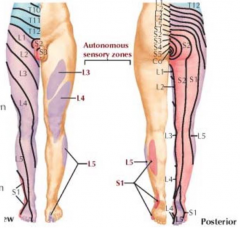
- L1: inguinal region
- L3: medial femoral condyle - L4: anterior knee / medial malleolus - L5: second toe / foot dorsum - S1: lateral heel - S2: popliteal fossa |
|
|
What nerve roots are responsible for HIP:
- Flexion? - Extension? |

- Flexion: L2, 3
- Extension: L5, S1 |
|
|
What nerve roots are responsible for KNEE:
- Flexion? - Extension? |

- Flexion: L3, 4
- Extension: L5, S1 |
|
|
What nerve roots are responsible for Ankle:
- Dorsiflexion? - Plantarflexion? |

- Dorsiflexion: L4, 5
- Plantarflexion: S1, 2 |
|
|
What nerve roots are responsible for foot:
- Inversion? - Eversion? |

- Inversion: L4, 5
- Eversion: L5, S1 |
|
|
What happens in "whiplash"? Cause?
|
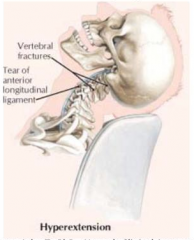
- Cervical hyperextension - stretched or torn cervical muscles and in severe cases, ligament, bone, or nerve damage
- Rear-end vehicular accident |
|
|
What are the ligaments of the vertebral column?
|

- Anterior longitudinal ligament
- Posterior longitudinal ligament - Ligamentum flavum - Interspinous ligament - Supraspinous ligament |
|
|
What are the key cervical dermatomes?
|
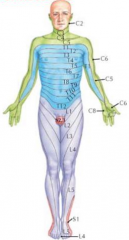
- C4 - AC joint
- C5 - lateral antecubital fossa - C6 - thumb - C7 - middle finger - C8 - little finger |
|
|
What are the key thoracic dermatomes?
|
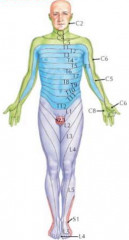
- T1 - median antecubital fossa
- T4 - nipple - T10 - umbilicus (belly button) - T12-L1 - inguinal / groin region |
|
|
What is the most common infection of the peripheral nervous system?
|
Herpes Zoster (Shingles) - acute neuralgia confined to dermatome distribution of a specific spinal or cranial sensory nerve root
|
|
|
What is the presentation of Herpes Zoster (Shingles)?
|
- Vesicular rash confined to a radicular or cranial nerve sensory distribution
- Initial intense burning, localized pain w/ vesicles appears 72-96 hrs later |
|
|
What are the most common sites affected by Herpes Zoster (Shingles)?
|
One or several contiguous dermatomes (T5-L2), CN V (semilunar ganglion), or CN VII (geniculate ganglion)
|
|
|
Where do you do a lumbar puncture / deliver epidural anesthesia?
|
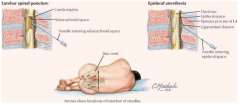
- Subarachnoid space of lumbar cistern (lumbar puncture) or epidural space (epidural)
- Midline between L3 and L4 or L4 and L5 (around area of iliac crests) |
|
|
Where does the spinal cord end?
|
L1/L2
|
|
|
What causes spina bifida?
|
Low folic acid ingestion during first trimester
|
|
|
Where does spina bifida occur most frequently?
|
L5 or S1
|
|
|
What are the different degrees of Spina Bifida?
|
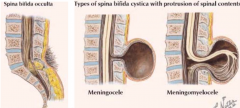
- Occulta - missing neural arch of vertebra
- Meningocele - meninges and CSF protrude as cyst - Meningomyelocele - meninges and cord itself protrude as cyst |
|
|
What are the neurologic symptoms related to spinal nerve root(s) or cord compression?
|
- Extremity pain
- Numbness - Tingling - Weakness - Bowel/bladder urgency/incontinence |
|
|
What diagnosis do you need to rule out when a patient presents with loss of bowel or bladder control?
|
Myelopathy (spinal cord) or Stenosis (narrowing of spinal column)
|
|
|
What diagnosis do you need to rule out when a patient presents with significant weakness?
|
Myelopathy (spinal cord) or radiculopathy (nerve root)
|
|
|
What diagnosis do you need to rule out when a patient presents with saddle anesthesia?
|
Myelopathy (spinal cord) or Cauda Equina Syndrome
|
|
|
What diagnosis do you need to rule out when a patient presents with chronic corticosteroid use?
|
Compression fracture
|
|
|
What diagnosis do you need to rule out when a patient presents with prior spine surgery?
|
- Hardware failure
- Adjacent segment disease - Recurrent disc herniation |
|
|
If a patient <40 yo presents w/ morning stiffness that improves w/ activity but not w/ rest, what should you suspect?
|
Spondyloarthropathy - joint disease of the vertebral column
|
|
|
What are the cervical spine physical landmarks?
|
- C3: hyoid bone
- C4-5: thyroid cartilage - C6: first cricoid ring - C7: most prominent spinous process |
|
|
What are the lumbar/sacral spine physical landmarks?
|
- L4/5: top of iliac crest
- S2: PSIS |
|
|
What pathologic reflexes would indicate an upper motor neuron process?
|
- Hoffman - passive rapid flexion of middle finger distal phalynx (positive = flexion of thumb, index finger)
- Babinski - stroking sole of foot resulting in great to extension and toe spreading |
|
|
What is a myotome?
|
Collection of muscle fibers innervated by the motor axons within each segmental nerve (root)
|
|
|
How do you test motor innervation of important cervical / thoracic spinal nerves?
|
- C5: biceps (elbow flexor)
- C6: extensor carpi radialis (wrist flexor) - C7: triceps (elbow extensor) - C8: flexor digitorum profundus (3rd) (distal finger flexor) - T1: abductor digiti minimi (little finger abduction) |
|
|
How do you test motor innervation of important lumbar/sacral spinal nerves?
|
- L2: ilipsoas (hip flexor)
- L3: quadriceps (knee extensor) - L4: tibialis anterior (ankle dorsiflexor) - L5: extensor hallicus longus (big toe extensor) - S1: gastrocnemius (ankle plantarflexor) |
|
|
What are the important reflexes to test?
|
- C5: biceps
- C6: brachioradialis - C7: triceps - L4: quadriceps (patellar) - L5: medial hamstring - S1: gastrocnemius (achilles) |
|
|
What is Lhermitte's sign? What is positive?
|
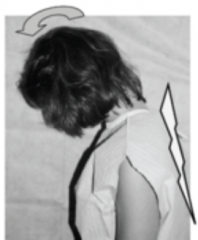
Passive anterior cervical flexion elicits "electric-like" sensation down the spine or extremities --> implies cervical spinal cord pathology
|
|
|
What is Spurling's sign? What is positive?
|
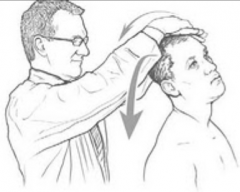
Reproduction of radicular (nerve root) symptoms w/ cervical spine extension, rotation, and lateral flexion --> positive implies cervical nerve root pathology
|
|
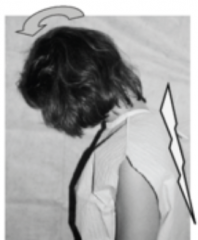
What is this testing?
|
Lhermitte's sign - Passive anterior cervical flexion elicits "electric-like" sensation down the spine or extremities --> implies cervical spinal cord pathology
|
|
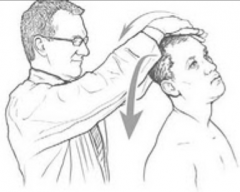
What is this testing?
|
Spurling's test - Reproduction of radicular (nerve root) symptoms w/ cervical spine extension, rotation, and lateral flexion --> positive implies cervical nerve root pathology
|
|
|
What do you do in the straight-leg test / Lasegue sign? Positive?
|
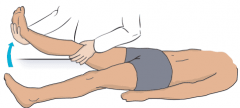
Patient lies supine while leg is raised w/ knee extended; stop raising leg when patient reports pain --> LEG pain reproduced at 30-70 degrees (implies lumbar nerve root pathology - L5/S1)
|
|
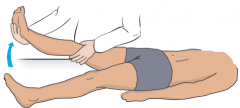
If this elicits leg pain, what does this imply?
|
Lumbar nerve root pathology (L5 or S1)
|
|
|
What do you do in the femoral nerve stretch test? Positive?
|
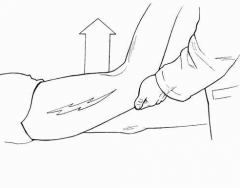
- Patient is placed in prone position while knee is flexed
- Positive: reproduce pain in anterior thigh - Implies upper lumbar nerve root pathology (L2-L4) |
|
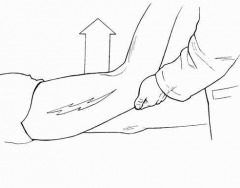
If this elicits leg pain, what does this imply?
|
Upper lumbar nerve root pathology (L2-L4)
|
|
|
If a patient has the following symptoms what should you be thinking of as the cause?
- Spasticity/hypertonicity - Increased reflexes - Positive pathological reflexes - Extensor plantar response |
Upper Motor Neuron Injury
- Spinal cord injury - Brain injury / stroke - Myelopathy - CNS lesion |
|
|
If a patient has the following symptoms what should you be thinking of as the cause?
- Flaccid weakness - Loss of reflexes - Muscle wasting and atrophy |
- Peripheral nerve entrapment
- Radiculopathy |
|
|
What are the red flags for when to suspect malignancy?
|
- History of cancer
- Unexplained weight loss - > 50 yo |
|
|
What are the red flags for when to suspect a spinal fracture?
|
- Major trauma
- Minor trauma or strenuous lifting in older or potentially osteoporotic individual - Prolonged corticosteroid use - Osteoporosis - Age >70 yo |
|
|
What are the red flags for when to suspect an infection?
|
- Constitutional symtoms (e.g. fever, chills)
- Recent bacterial infection (e.g. urinary tract or skin infections, pneumonia) - Immunosuppression - Intravenous drug abuse |
|
|
28 y male presents w/ right sided low back pain 3 days ago while putting toddler into car seat; no radiation of pain, numbness, tingling, weakness; tender and hypertonic lumbar paraspinals, limited lumbar ROM, normal neuro.
What is it / what should you do? |
Lumbar Strain:
- No imaging necessary - Recommend relative rest <48 hrs - NSAIDs - Muscle relaxant - Physical therapy if >4 wks or recurring - Should be self-limited |
|
|
Lumbar Strain:
- History - Etiology - Exam - Treatment |
- History – axial low back pain after acute injury, such as lifting or twisting
- Etiology – muscle disruption from excessive stretch or tension - Exam – localized muscle tenderness, reduced ROM - Treatment – no imaging, relative rest, NSAIDs, muscle relaxant, physical therapy if >4 wks |
|
|
37 y painter w/ 2 weeks of progressive pain in neck and right scapular pain and arm; > 1 week of shooting pain and numbness down arm to hand; numbness in arm into hand and arms feel weak; positive Spurling (extension of neck), weak elbow extension, decreased pain over middle finger.
What reflex would you expect to be abnormal? |
Absent triceps reflex
|
|
|
37 y painter w/ 2 weeks of progressive pain in neck and right scapular pain and arm; > 1 week of shooting pain and numbness down arm to hand; numbness in arm into hand and arms feel weak; positive Spurling (extension of neck), weak elbow extension, decreased pain over middle finger.
What is it / what should you do? |
- Radiculopathy (probably disc herniation)
- Imaging: MRI, possible EMG - Relative rest, Physical therapy - Surgical discectomy if progressive/severe weakness or unresponsive to conservative care - Pain: NSAIDs, oral or epidural corticosteroids, limited opioids, neuromodulators |
|
|
Radiculopathy:
- History - Etiology - Exam - Treatment |
- History – pain and possible numbness/weakness in limb > axial spine (lumbar: worse sitting/flexion, better standing/extension)
- Etiology – disc herniation most common - Exam – SLR or Spurling positive, neurologic deficits (myotomal weakness, decreased reflex, dermatomal reduced sensation) - Treatment – Imaging: MRI, possible EMG. Relative rest, physical therapy, surgical discectomy if progressive/ severe weakness or unresponsive to conservative care. For pain, NSAIDs, oral or epidural corticosteroids, limited opioids, neuromodulators |
|
|
What are the most comfortable positions for someone with a lumbar disc herniation?
|
- Laying down
- Standing up straight better than sitting up straight |
|
|
34 y male presents with chronic back stiffness and pain that has been getting worse for the past few years, stiffness is worse in morning and loosens up somewhat by mid-day, but he has difficulty getting up from chair after prolonged sitting; he feels better when he exercises. Decreased back ROM w/o neurological defects.
What is it / what should you do? |
Ankylosing Spondylitis (inflammatory spondyloarthropathy)
- Plain x-rays - earliest finding is sacroiliitis - Labs: HLA-B27, C-reactive protein, Sed rate - Meds: NSAIDs typically marked relief, Anti-TNF agents - PT - emphasis on spine extension |
|
|
Ankylosing Spondylitis:
- History - Etiology - Exam - Treatment |
- History – onset of low back pain < age 40, insidious, better with exercise, pain at
night and on waking, not improved with rest - Etiology – inflammatory spondyloarthropathy, usually sacroiliitis initially. Can be associated with uveitis, inflammatory bowel disease, psoriasis among other features - Exam – Reduced lumbar ROM, often tender to palpation over sacroiliac joints with positive joint provocative tests (FABER, Gaenslen). - Treatment – Imaging: plain x-rays – earliest finding sacroiliitis. Later syndesmophytes can progress to “bamboo spine”. Labs: HLAB27, C-reactive protein, sed rate. NSAIDs – typically marked relief. Consider anti-TNF agents. Physical therapy, emphasis on spine extension |
|
|
What are the early signs of Ankylosing Spondylitis?
|
- Widening of SI joints w/ adjacent sclerosis compatible w/ sacroiliitis
- Posterior longitudinal ligament sclerosis at L1-L2, L2-L3 |
|
|
What are the late signs of Ankylosing Spondylitis?
|
- Fusion of both SI joints, compatible w/ advanced sacroiliitis
- Symmetric syndesmophytes bridging all all vertebral bodies resulting in "bamboo spine" - Ossification of anterior, posterior, and interspinous longitudinal ligaments |
|
|
59 y female w/ low back ache for several months, limits standing and walking. No injury or trauma. No pain sitting. Central, low midline lumbar pain. No LE referral, numbness, tingling, or weakness.
What is it / what should you do? |
Facet joint arthropathy / Osteoarthritis
- Imaging: none or plain lumbar x-rays. - Meds: NSAIDs, mild analgesics. - Physical therapy (flexion bias) - Possibly facet joint injections |
|
|
Osteoarthritis (facet joints):
- History - Etiology - Exam - Treatment |
- History – axial low back pain, gradual onset (cervical: worse with cervical extension; lumbar: worse standing/walking, better sitting/lying)
- Etiology – gradual degenerative changes/osteoarthritis to zygoapophyseal (facet) joints; more common age > 55 - Exam – nonspecific, pain provoked with active extension, relieved with flexion - Treatment – Imaging: none or plain lumbar x-rays. NSAIDs, mild analgesics. Physical therapy (flexion bias), possibly facet joint injections |
|
|
77 y male w/ 1 year of intermittent low back pain, w/ pain down both legs to ankles when walking >1/4 mile. Pain resolves w/ sitting and no pain in bed. No numbness, tingling, or weakness. Reduced lumbar ROM (pain-free) and mildly decreased Achilles reflex bilaterally).
What is it / what should you do? |
Lumbar Stenosis (L3-L4)
- Imaging: MRI, possibly CT or EMG. - Meds: NSAIDs, neuromodulators, epidural steroids - Physical therapy (flexion bias), use of walker - Surgery for lumbar decompression |
|
|
Lumbar Stenosis:
- History - Etiology - Exam - Treatment |
- History – slowly progressive back and unilateral or bilateral leg pain (worse standing/walking, better sitting). Shopping cart sign – can walk much further if pushing cart (flexes spinal canal). Differentiate from vascular claudication (must sit or bend to relieve symptoms)
- Etiology – narrowing of the spinal canal (due to disc herniation/protrusion, ligamentum flavum thickening, osseous thickening of bone/facet joint, spondylolisthesis) - Exam – nonspecific. Possibly flexed standing posture, reduced lumbar lordosis; otherwise unremarkable - Treatment – Imaging: MRI, possibly CT or EMG. NSAIDs, neuromodulators, physical therapy (flexion bias), use of walker, epidural steroids, surgery for lumbar decompression |
|
|
65 y healthy female w/ 2 weeks of severe low back pain after playing vigorously w/ grandchildren. No leg pain or numbness/tingling. No red flags besides age. Exam w/ local tenderness in upper lumbar region, normal neuro exam.
What is it / what should you do? |

Osteoporosis / Compression Fracture
- Imaging: plain x-rays, possibly MRI or CT; DEXA scan to eval for osteoporosis. - If malignancy considered: CBC, SPEP, alkaline phosphatase, sed rate. - Meds: NSAIDs, acetaminophen, calcitonin, mild opioids. - Consider bracing for 6 weeks. Physical therapy. - Symptoms usually improve in 3 months. - Vertebroplasty/kyphoplasty a consideration, evidence of efficacy limited. |
|
|
Compression Fracture
- History - Etiology - Exam - Treatment |
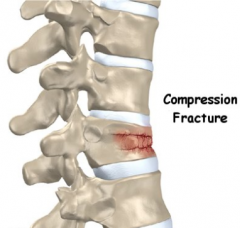
- History – usually sudden thoracic or lumbar pain, often little to no trauma
- Etiology – majority related to osteoporosis, older patients; anterior vertebral body wedge fracture. T10, T11, T12, L1 most commonly. In younger patients w/o clear etiology, consider malignancy, multiple myeloma. 1/3 are asymptomatic - Exam – tender over spinous processes, paraspinals. Worse: lumbar flexion. Better: lumbar extension. Normal neuro exam (unless nerve root affected). - Treatment – Imaging: plain x-rays, possibly MRI or CT; DEXA scan to eval for osteoporosis. If malignancy considered: CBC, SPEP, alkaline phosphatase, sed rate. NSAIDs, acetaminophen, calcitonin, mild opioids. Consider bracing for 6 weeks. Physical therapy. Symptoms usually improve in 3 months. Vertebroplasty/kyphoplasty a consideration, evidence of efficacy limited. |
|
|
What are some underlying conditions that predispose to developing a compression fracture?
|
- Osteoporosis (most common)
- Paget's disease (disorganized bone remodeling) - Multiple Myeloma - Breast Cancer - Diabetes |
|
|
36 y executive chef w/ history of chronic low back pain. 1 week ago w/ increased pain and new right > left posterior thigh and calf pain after long flight. 4 days ago worsening back and leg pain, saddle anesthesia, which persists. 1 episode of bowel incontinence, difficulty emptying bladder, and leg weakness.
What is it / what should you do? |
Cauda Equina Syndrome
- Surgical emergency |
|
|
Cauda Equina Syndrome
- History - Etiology - Exam - Treatment |
- History – leg pain, numbness, weakness; saddle anesthesia; bowel/bladder
dysfunction (urinary retention most common; urinary or stool incontinence) - Etiology – large herniated disc compressing cauda equina most common (also epidural tumor, abscess, or hematoma) - Exam – reduced or absent reflexes, weakness, decreased rectal tone - Treatment – Surgical emergency |
|
|
74 yo w/ gradual progression of "walking funny". He notes 4 falls in past month d/t losing his balance, difficulty w/ buttoning his shirt and pants. Hyperreflexia at triceps, patellas, and Achilles, positive Hoffman's and Babinski, mild weakness of hand intrinsics and diffuse in legs, wide based gait w/ poor balance.
What is it / what should you do? |
Cervical Myelopathy
- Imaging: MRI. - Surgical decompression (laminectomy) - may not correct neurological deficits, but will prevent progression - No role for nonoperative treatment (unless not a surgical candidate) |
|
|
Cervical Myelopathy:
- History - Etiology - Exam - Treatment |
- History – pain, numbness, weakness in arms and/or legs; balance and gait difficulties;
bowel/bladder dysfunction - Etiology – cervical canal stenosis with spinal cord compression - Exam – arm and/or leg weakness, upper motor neuron signs (hyperreflexia, Hoffman/Babinski, gait ataxia, increased tone) - Treatment – Imaging: MRI. Surgical decompression. No role for nonoperative treatment. |

